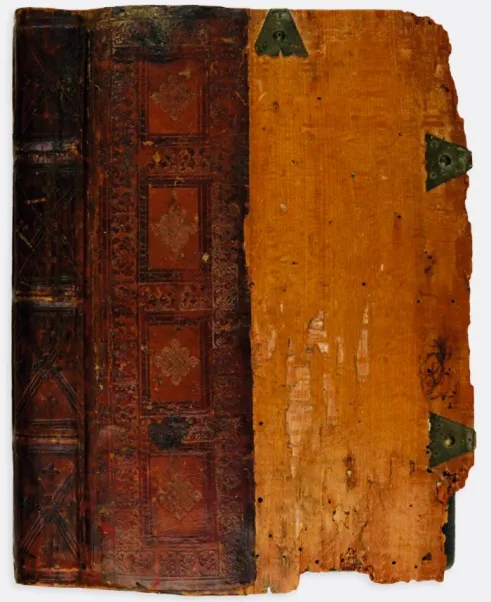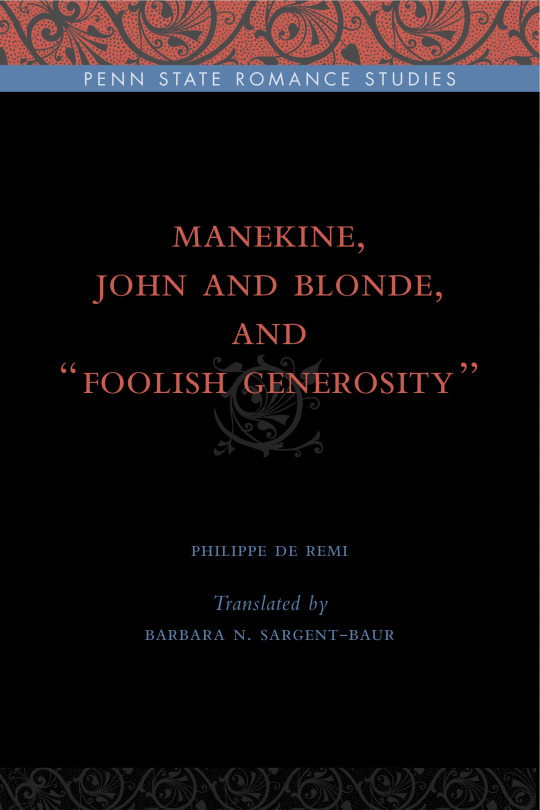#Thirteenth Century
Text

Cozy conflict
Two elephants fight in a copy of Ibn Bakhtishu (d. 1058)'s Manafi al-Hayawan (On the Uses of Animals), made c. 1297-1300 in the area that is now Iran. But while the elephants are fighting, the images and text reveals how humans shared knowledge and ideas across long distances.
The text mentions that elephants live 300 years and are afraid of rats/mice. These and other ideas about elephants that also showed up in European texts at least since Pliny. The Morgan catalogue also notes that the text claims that elephant dung (with or without honey) can be taken as a contraceptive: don't try this at home!
Meanwhile, some scholars argue that the images resemble Gok Medrese reliefs in Turkey, and both may have been inspired by art from China brought by the Mongols, who swept across Eurasia in the thirteenth century. This single page is a very interesting example of how ideas about elephants can reveal wider influences and links between humans.
Materials: Paper, ink, and paint
Origin: Maragha
Date: 1297-1300
Now Morgan Library, M 500, f. 13r
51 notes
·
View notes
Text


#821 year anniversary of john's Nephew Murder Moment#thirteenth century#prince arthur#king john#King John and Arthur of Brittany by JC Holt
7 notes
·
View notes
Text

Glass Fragment of a Devil, French, 1200-1215 CE
22 notes
·
View notes
Text

Disenchanting Albert the Great: The Life and Afterlife of a Medieval Magician by David J. Collins S. J. (Aug. 13, 2024)
Albert the Great (1200–1280) was a prominent Dominican friar, a leading philosopher, and the teacher of Thomas Aquinas. He also endorsed the use of magic. Controversial though that stance would have been, Albert was never punished or repudiated for what he wrote. Albert’s reception followed instead a markedly different course, leading ultimately to his canonization by the Catholic Church in 1931. But his thoughts about magic have been debated for centuries. Disenchanting Albert the Great takes Albert’s contested reputation as a case study for the long and complex history surrounding the concept of magic and magic’s relationship to science and religion.
Over the centuries, Albert was celebrated for his magic, or it was explained away―but he was never condemned. In the fifteenth century, members of learned circles first attempted to distance Albert from magic, with the goal of exonerating him of superstition, irrationality, and immorality. Disenchanting Albert the Great discusses the philosopher’s own understanding of magic; an early, adulatory phase of his reputation as a magician; and the three primary strategies used to exonerate Albert over the centuries.
In the end, Disenchanting Albert the Great tells the story of a thirteenth-century scholar who worked to disenchant the natural world with his ideas about magic but who himself would not be disenchanted until the modern era. This accessible and insightful history will appeal to those interested in Albert the Great, Catholic Church history, the history of magic, and Western understandings of the natural and the rational over time.
David J. Collins, S.J., is an Associate Professor of History at Georgetown University. He is the editor of The Sacred and the Sinister: Studies in Medieval Religion and Magic, also published by Penn State University Press.
1 note
·
View note
Text
Walter Burley one of the most prominent logicians and metaphysicians of the Middle Ages
284J Aristotle , Gualtherus Burlaeus. (Walter Burley (c. 1275–1344/5 ))
Expositio Gualteri Burlei super decem Libros Ethicorum Aristotelis (Contains the text of Robert Grosseteste’s translation of the Nicomachean Ethics)
Venice: Simon de Luere for Andreas Torresanus, 4 September 1500 $11,500
Folio, 12 1/4 X 8 1/2 in. A8 a6 b-x8 y10.
Second edition after the first of 1481.
This copy is bound…

View On WordPress
#Buridan Agent Intellect Buridan Common Sense Buridan Hylomorphism Buridan Intelligible Species Buridan Intentions Buridan Phantasms Buridan#Buridan Aristotle#Buridan Common Sense#Buridan Materialism#Medieval Psychology#thirteenth century
0 notes
Text
Unlocked Book of the Month: Manekine, John and Blonde, and “Foolish Generosity”

About our March pick:
Philippe de Remi (1200/1210–65) holds a remarkable position in the legacy of the thirteenth-century literary world. A layman, landholder, and professional administrator, rather than a court poet or member of the clergy, Philippe de Remi wrote poems, songs, and long verse narratives that were grounded in his familiarity with the literary genres of his day. While Philippe paid homage to Chrétien de Troyes and other important secular writers of the period, his station in society and an intended audience of family and friends, not patrons, allowed him the freedom to treat courtly conventions with some independence and to explore human motivations across the social spectrum. Barbara Sargent-Baur brings to the modern English-speaking reader a translation of three of Philippe’s most important compositions: his two verse romances, Manekine and John and Blonde, as well as his single short verse tale, “Foolish Generosity.” This volume gathers the first English stand-alone prose translations of these romances, which have been previously published only as line-by-line versions facing the Old French originals. Sargent-Baur’s English translation of “Foolish Generosity” is the first rendering from Old French in any language. These important translations allow increased access to Philippe de Remi’s attractive narrative works, expanding their audience beyond an Old French readership to the wider academic community.
Read more & access the book here: https://www.psupress.org/books/titles/978-0-271-02761-6.html
See the full list of Unlocked titles here: https://www.psupress.org/unlocked/unlocked_gallery.html
#Literary Studies#Medieval#Romance#Philippe de Remi#Thirteenth Century#13th Century#Poems#Poetry#Songs#Music#long Verse#Poet#Manekine#John and Blonde#Foolish Generosity#PSU Press#PSU Press Unlocked
0 notes
Text

a time lady
#13 has never looked this serene in her life but hey#so I was watching arc of infinity right#and realised that High Chancellor Thalia’s dress so looks like a 16th century burgundinian/‘the Holbein Anne of Cleves portrait’ dress#and then this happened#possibly my nerdiest art ever lol#I almost drew lala in this fit but I haven’t drawn 13 in ages sooooo have#thirteenth doctor#13th doctor#Jodie Whittaker#Doctor who#Gallifrey#time lord#time lady#my art#fanart#minsart#they should have put Jodie in time lord garb tbh she would so pull it off
445 notes
·
View notes
Text
Honestly my biggest complaint about s11 is the lack of Historical costumes for the fam. There's just something about the Doctor's friends in full 'accurate' dress while they just prance around looking like a gay fever dream.
#seems like a waste#so no one bats an eyelash at the jeans jacket?#in 17th century england??#and what is your field of expertise my nubian prince?#king james is so queer in this episode#but fuck him tbh#im rewatching doctor who#doctor who#dw#doctor who series 11#doctor who season 11#thirteenth doctor#13th doctor#ryan sinclair#yazmin khan#graham o'brien#dw s11 e8#the witchfinders#alan cumming#king james#text post#og post#gifsaregifts
55 notes
·
View notes
Photo







#dwedit#doctor who#thasmin#the doctor#thirteen#thirteenth doctor#yasmin khan#the vanquishers#jodie whittaker#mandip gill#my gifs#thasmin*#thirteen*#yaz*#and i'd like another century with these two please and thank you
421 notes
·
View notes
Text
NOOOOO I just spent a few hours writing up an answer to an ask and I tried to save it as a draft and it disappeared ;-; why does god hate me
#@ anon who asked about colin's comment about german source code and albrecht von closen: I will try and rewrite my answer#because you point out something that I've been thinking about as well and I want to lay it all out in one place#but it might be coming tomorrow instead of today#my beautiful cited and sourced information about thirteenth century german nobility....#marina marvels at life
44 notes
·
View notes
Text
#tumblr polls#dcom#disney#disney channel#disney channel original movie#disney channel movies#disney movies#disney polls#under wraps#you lucky dog#brink!#halloweentown#zenon girl of the 21st century#can of worms#the thirteenth year#smart house#johnny tsunami#genius#don’t look under the bed#horse sense#1990s movies
24 notes
·
View notes
Text
Philip and John had much in common. They were born just a year apart. John's mother had been married to Philip's father. Philip's half-sister, Margaret, married John's brother Henry. Philip's sister Alice was betrothed to Richard and a possible wife for John. In his youth John went to Paris. During Richard's captivity they were allies. As kings they were opponents in a conflict which brought success, conquest and glory to Philip, failure and defeat for John. Summit conferences between them were regular. At one they came "face to face for an hour, no one except themselves being within hearing." At another, "no one spoke except those two", after which John went on to Paris as Philip's guest.
-Jim Bradbury, Philip Augustus and King John
#king john#philippe auguste#thirteenth century#and I hope they were so unwell and toxic about it <3 hatred and violence on planet earth <3
7 notes
·
View notes
Text

Reliquary of Saints Lucian, Maxian, and Julian, Paris, ca. 1261-1262.
12 notes
·
View notes
Text
Anyways I think the thing that makes loki and sigyn hit different to other tragic love stories for me is that they know this is a tragedy. Like, Ragnarök seems to be pretty common knowledge, sigyn knows how this ends, she knows exactly what will happen. And she still stays. And the whole snake torture cave is an indicator of just how loyal she is, sure, but so is everything else before that because she's not mentioned in the prophecy, she could just walk away and she'd be fine but she doesn't, she won't, she can't. And in other tragedies I've seen the main characters at least have the hope that it will all be fine, even if the audience knows better, that they'll make it through together and walk off into the sunset but loki and sigyn don't even have that. All they have is each other and all they can hope for is just one more day. I amn. Unwell
#thirteenth century doomed yuri save me#yes I have been listening to tongues and teeth on repeat all day what about it#norse mythology
9 notes
·
View notes
Text
Walter Burley
284J Aristotle , Gualtherus Burlaeus. (Walter Burley (c. 1275–1344/5 ))
Expositio Gualteri Burlei super decem Libros Ethicorum Aristotelis (Contains the text of Robert Grosseteste’s translation of the Nicomachean Ethics)
Venice: Simon de Luere for Andreas Torresanus, 4 September 1500 $11,500
Folio, 12 1/4 X 8 1/2 in. A8 a6 b-x8 y10.
Second edition after the first of 1481.
This copy is bound…

View On WordPress
#Buridan Agent Intellect Buridan Common Sense Buridan Hylomorphism Buridan Intelligible Species Buridan Intentions Buridan Phantasms Buridan#Buridan Aristotle#Buridan Common Sense#Buridan Materialism#Medieval Psychology#thirteenth century
0 notes
Text
anyway shoutout to my dissertation director for telling me I should switch out one of my chapters for hoccleve, I'm having such an easier time of pulling everything together now
#doing my notes like 'YES YESSS YES'#perfect transition between the chapters concerned more with the body part of nonnormative bodyminds and the one more concerned with the min#and so much of it fits so well with the work by remi yergeau I was already pulling in for that last chapter#AND I get to boot my beloathéd thirteenth century french romance right out of there#he also recommended considering a chapter on Chaucer but I will not be doing that thank you very much#I can pull the wife of bath into my last chapter for thematic parallels about gendered authorship and how her rhetoric works#but that is as much Chaucer as I am willing to put in there. I do not enjoy him
15 notes
·
View notes